Bilva (Aegle marmelos): Benefits and Uses of Bel Patra
In the realm of traditional medicine and natural remedies, the bilva tree (Aegle marmelos) stands as a treasure trove of wellness. With its myriad of health benefits, nutrient-rich profile, and deep-seated influence on Ayurvedic practices, bilva has captured the attention of health enthusiasts and seekers of holistic wellness. In this comprehensive guide, we delve into the world of bilva, shedding light on its qualities, uses, and the incredible impact it holds within the realm of Ayurveda.
What is Bilva? Unveiling the Essence
Bilva, scientifically known as Aegle marmelos, is a deciduous tree that flourishes in various parts of India and other Asian countries. Revered for its significant place in Ayurvedic practices, bilva is commonly referred to as the “Bel” tree and holds an esteemed position in traditional medicine systems. Its leaves, fruits, roots, and bark are all utilized for their therapeutic properties, making this tree a true powerhouse of natural healing.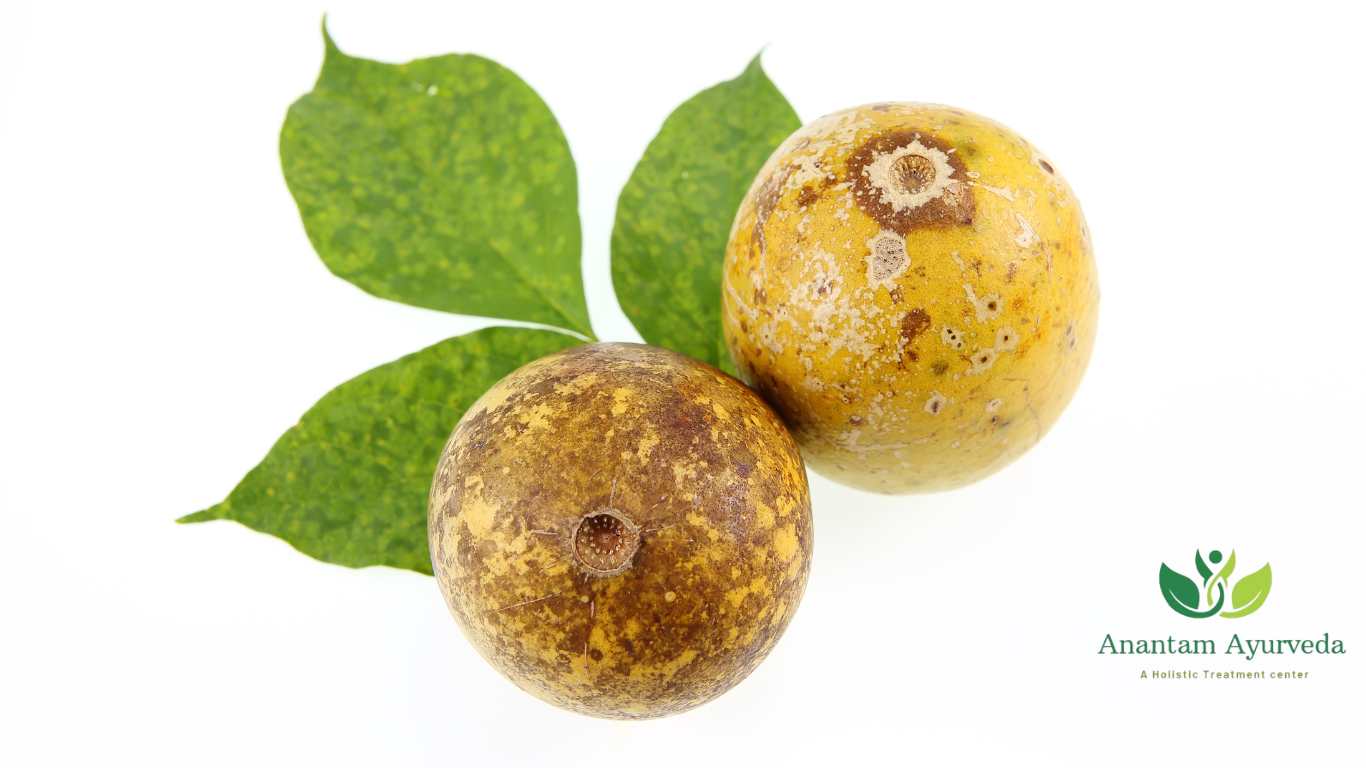
Sanskrit Synonyms of Bilva
- Maaloora – Alleviates all types of Mala dosha
- Shandilya – Cures many diseases
- Shailusha – Grows in hilly regions
- Shriphala – The fruit of Bilva is aromatic
- Gandhapatra – The leaves of Bilva are aromatic
- Sadaaphala – Bilva always bears fruit
- Mahakapittha – The fruit resembles a large Kapitta fruit
- Kantaki – Bilva is a thorny tree
- Granthila – The stem is nodular
- Atasara – It has carminative action
Morphology & Habitat of Bilva
Habitat
- Commonly found throughout India, particularly in dry deciduous forests and hilly regions.
Plant Morphology
- Root: Taproot, branched
- Stem: Erect, woody, cylindrical, and thorny
- Leaf: Trifoliate, aromatic, net-veined
- Inflorescence: Cymose, Axillary panicle
- Flowers: Small, white, fragrant, bisexual
- Fruit: Hard-shelled berry, aromatic
Geographical Distribution
- Found throughout India, especially in dry deciduous forests.
The Nutrient Profile and Useful Parts of Bilva
The various parts of the bilva tree are laden with essential nutrients that contribute to its incredible healing potential. The leaves are rich in tannins, flavonoids, and other bioactive compounds that confer antioxidant and anti-inflammatory benefits. The nutrient-packed fruits of the bilva tree are a source of vitamins, minerals, and dietary fiber, making them valuable additions to a balanced diet. Additionally, the bark and roots contain compounds that hold promise in promoting overall well-being.
- Marmelosin
- Tannic acid
- Fatty acids
- Essential oils
- Rutin
- Aegeline
- Marmesinin
Classical Categorization of Bilva
Charaka Samhita:
- Shothahara – Anti-inflammatory group
- Arshoghna – Beneficial in hemorrhoids
- Asthapanopaga – Supports Basti (enema) therapy
- Sthavara Sneha Yoni – Recognized as a plant source for oil
Sushruta Samhita:
- Varunadi, Ambashtadi, Brihat Panchamoola, Dashamoola – Important herbal formulations containing Bilva
Qualities of Bilva: An Ayurvedic Perspective
Bilva possesses a distinctive combination of gunas that contribute to its exceptional attributes and profound influence on health and wellness.
| Attribute | Description |
| Rasa (Taste) | Bitter (Tikta), Pungent (Katu), Astringent (Kashaya) |
| Guna (Quality) | Light (Laghu), Dry (Ruksha) |
| Virya (Potency) | Hot (Ushna) |
| Vipaka (Post-Digestive Effect) | Pungent (Katu) |
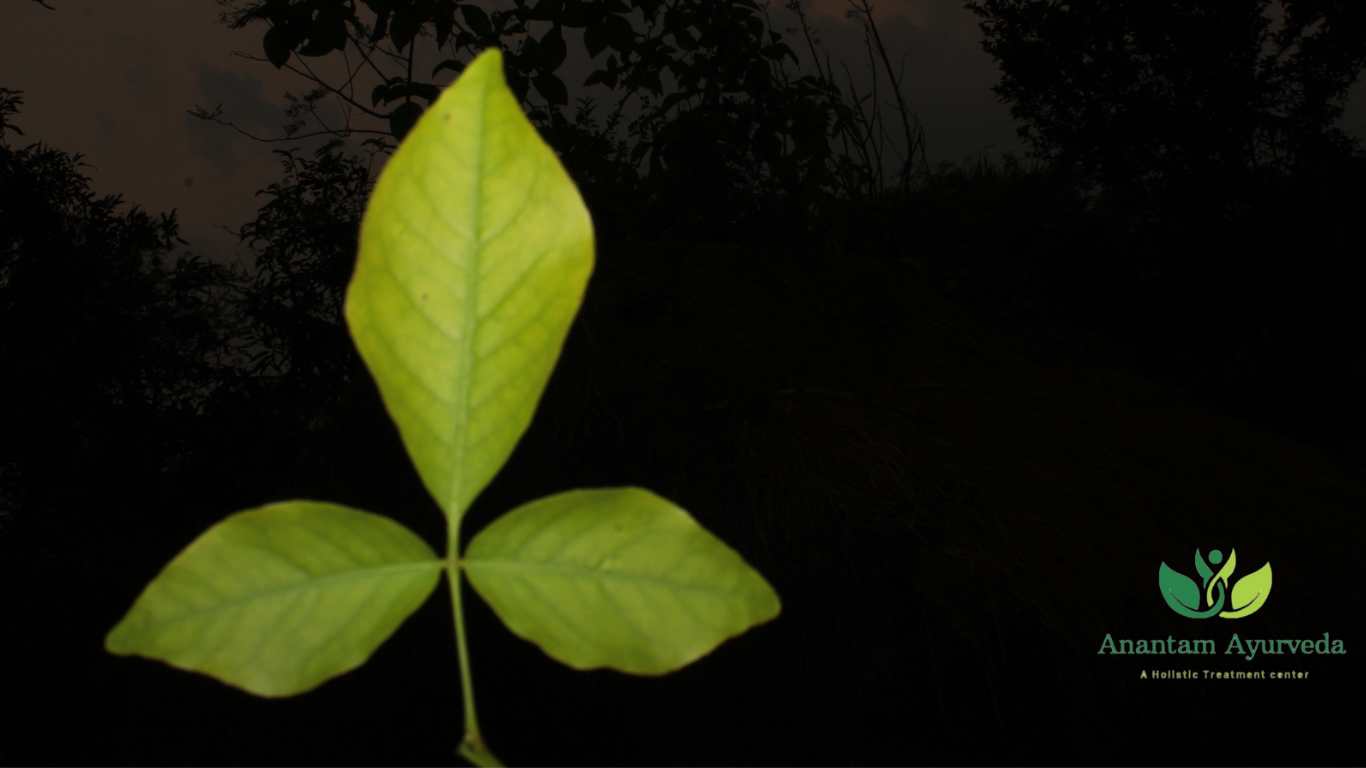
Influence on Doshas
Bilva’s qualities interact with these doshas in distinct ways, shaping its role in promoting overall well-being.
Vata Dosha: Bilva’s heating potency is well-suited to balance the cold, dry, and erratic nature of Vata dosha. By offering warmth and stability, Bilva helps soothe Vata imbalances, providing relief from symptoms such as anxiety, restlessness, and nervousness. Its calming effect supports a sense of tranquility and centeredness.
Kapha Dosha: With its pungent and heating qualities, Bilva becomes a valuable asset in balancing the heavy and stagnant attributes of Kapha dosha. By promoting circulation, reducing congestion, and enhancing metabolism, Bilva counteracts the tendencies of excess Kapha, revitalizing the body and mind.
Health Benefits of Bilva (Aegle marmelos)
From digestive support to immune enhancement, this remarkable botanical treasure holds the potential to positively impact our overall health.
1. Digestive Aid:
Bilva’s qualities make it an effective digestive tonic. Consuming bilva-based preparations can alleviate issues like indigestion, bloating, and constipation. Its ability to balance digestive processes aids in promoting regularity and comfort.
2. Immune Booster:
Rich in antioxidants and bioactive compounds, bilva enhances the immune system’s defense mechanisms. Regular consumption can help the body ward off infections, providing a shield against common ailments.
3. Diabetes Management:
Bilva’s leaves have been recognized for their potential to regulate blood sugar levels. This makes bilva a valuable component of diabetes management strategies, contributing to better glucose control.
4. Respiratory Support:
Bilva’s antimicrobial and anti-inflammatory properties extend to respiratory health. It can alleviate symptoms of cough, cold, bronchitis, and even asthma by reducing inflammation and promoting clear breathing.
5. Heart Health:
The presence of heart-friendly compounds in bilva supports cardiovascular wellness. It can help regulate blood pressure, lower cholesterol levels, and maintain a healthy heart rhythm.
6. Skin Care:
Bilva’s properties extend to skin health. Its antibacterial and anti-inflammatory effects make it a valuable addition to skincare routines, aiding in the management of acne, rashes, and other skin irritations.
7. Gastrointestinal Relief:
Bilva is known for its ability to soothe various gastrointestinal issues. It can provide relief from diarrhea, dysentery, and irritable bowel syndrome by promoting intestinal health and reducing inflammation.
8. Wound Healing:
The antimicrobial nature of bilva extends to wound care. Its application can help prevent infections and expedite the healing process, making it a traditional remedy for external injuries.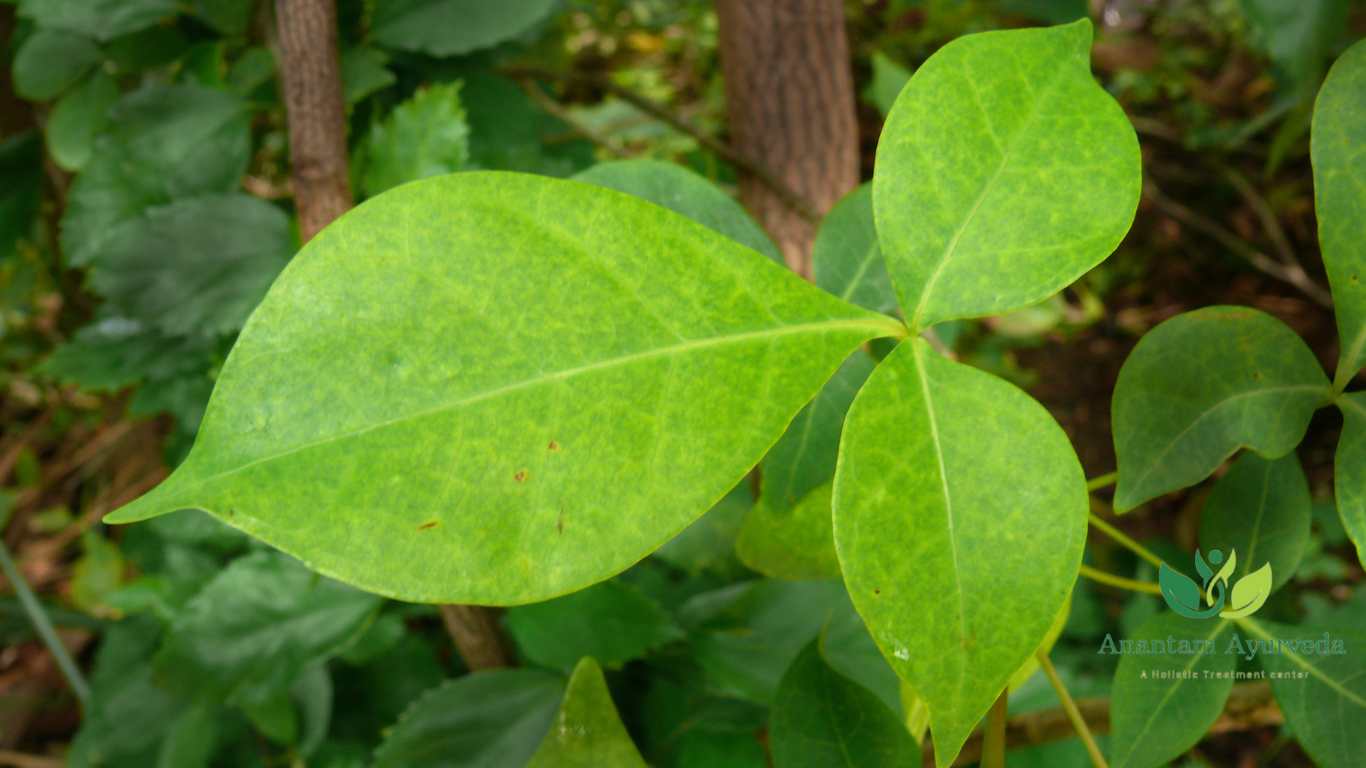
9. Stress Reduction:
Bilva’s calming properties have a positive impact on mental well-being. Incorporating bilva into daily routines can help alleviate stress, anxiety, and promote a sense of relaxation.
10. Weight Management:
Bilva’s metabolism-enhancing qualities make it a potential aid in weight management. By promoting digestion, boosting metabolism, and regulating appetite, it can support healthy weight goals.
11. Anti-Inflammatory Action:
Bilva’s anti-inflammatory properties can benefit conditions characterized by inflammation, such as arthritis and joint pain. Its natural compounds help reduce inflammation and associated discomfort.
12. Liver Health:
Bilva’s impact on liver health is notable. It aids in detoxification, promotes the removal of toxins from the body, and supports optimal liver function.
From its role in soothing digestion to its impact on immunity and beyond, bilva’s wide-ranging health benefits underscore its significance in natural healing and wellness practices.
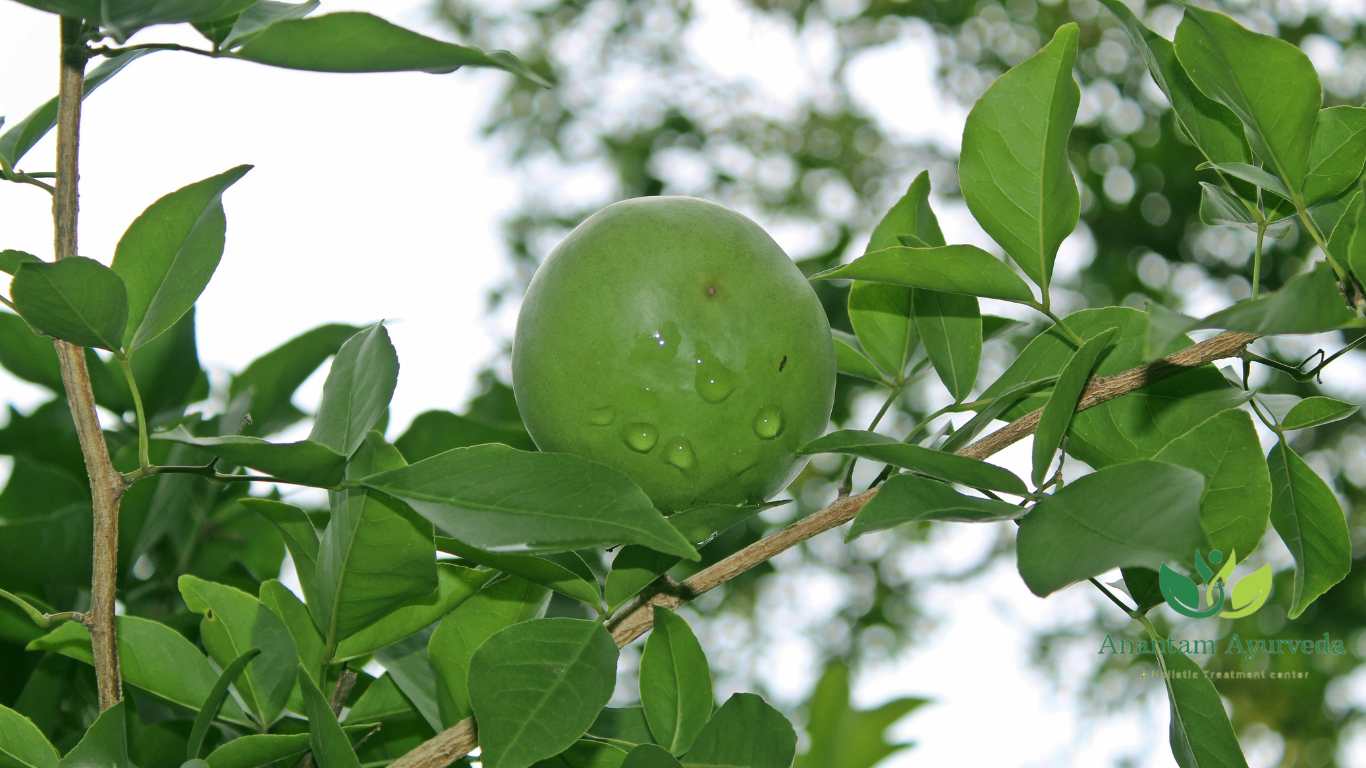
Parts Used & Dosage
| Part Used | Dosage |
|---|---|
| Root (Mula) | Used in decoctions and pastes |
| Unripe Fruit (Phala – Apakwa) | 1-2 g (powder) |
| Leaves (Patra) | 10-20 ml (juice) |
Properties and Uses of Different Parts of The Bael (Aegle marmelos):
| Part of Bael | Properties | Uses |
|---|---|---|
| Unripe Bael Fruit | – Kapha anila hara: Balances Vata and Kapha – Teekshna: Piercing – Snigdha: Oily – Sangrahi: Absorbent – Deepana: Improves digestion – Katu, Tikta, Kashaya: Pungent, Bitter, Astringent – Ushna: Hot |
– Balances Vata and Kapha – Improves digestion – Stimulates digestive power – Increases Pitta |
| Young Unripe Bael Fruit | – Snigdha: Oily – Ushna: Hot – Teekshna: Piercing – Pittavardhana: Increases Pitta – Deepana: Improves digestion – Kapha Vatajit: Balances Kapha and Vata |
– Balances Kapha and Vata – Stimulates digestion – Increases Pitta |
| Ripe Bael Fruit | – Durjara: Difficult to digest – Doshala: Aggravates all doshas – Pooti Maruta: Causes foul-smelling flatus – Madhura anurasa: Sweet aftertaste – Guru: Heavy to digest – Vidahi: Slight burning sensation – Vishtambhakara: Causes constipation |
– Useful in diarrhea and dysentery – Not ideal for digestion – Can cause Vata imbalance |
| Bael Root | – Tridoshaghna: Balances Tridosha – Chardighna: Relieves vomiting – Madhura: Sweet – Laghu: Light to digest |
– Balances all doshas – Alleviates vomiting – Easy on digestion |
| Bael Leaves | – Sangrahi: Absorbent – Vatajit: Balances Vata |
– Used in dyspepsia, gastritis, cold, and sinusitis |
| Bael Pith | – Kaphavataghna: Balances Kapha and Vata – Amaghna: Relieves indigestion – Shulaghna: Relieves abdominal pain – Grahini: Absorbent |
– Relieves digestive issues and indigestion – Soothes abdominal cramps |
| Bael Stem | – Kasaghna: Relieves cough and cold – Amavataghna: Useful for rheumatoid arthritis – Hrudya: Good for heart – Agnivardhana: Improves digestion – Katu, Kashaya, Ushna, Tikta: Pungent, Astringent, Hot, Bitter – Deepana, Pachana: Digestive |
– Relieves cough and cold – Helps with arthritis – Promotes heart health – Improves digestion |
| Bael Flower | – Atisarahara: Relieves dysentery and diarrhea – Trushahara: Relieves thirst – Vamihara: Anti-vomiting |
– Useful for dysentery and diarrhea – Relieves thirst – Prevents vomiting |
| Bael Fruit Oil | – Hot in nature – Relieves Vata |
– Relieves Vata disorders |
| Bael Fruit in Sour Gruel | – Carminative: Improves digestion | – Improves digestion – Relieves gas and bloating |
How to Use Bilva (Aegle marmelos)
Its versatile nature allows for various methods of incorporation, tailored to individual constitution and health goals. Here’s a guide on how to effectively use Bilva in Ayurveda:
- Bilva Juice: Extracting fresh juice from ripe Bilva fruits is a common Ayurvedic practice. Consume this juice in the morning on an empty stomach to kickstart your digestion and boost immunity. Bilva juice is particularly effective for alleviating digestive issues and promoting overall wellness.
- Bilva Powder: Create Bilva powder by drying and grinding Bilva leaves and fruits. This powder can be added to warm water, herbal teas, or incorporated into recipes. Its astringent and bitter taste supports digestion and can aid in managing conditions related to excess Kapha dosha.
- Decoctions (Kashaya): Boil Bilva leaves, fruits, or even its bark in water to make a potent decoction. This concentrated liquid is beneficial for various ailments, including respiratory issues, digestive discomfort, and promoting detoxification.
- Herbal Formulations: Bilva is a crucial component of many Ayurvedic formulations. Combining it with other herbs can create specialized remedies for specific health concerns. Consult an Ayurvedic practitioner to find formulations tailored to your needs.
- External Applications: Bilva’s antimicrobial properties make it suitable for external use. Create poultices or infused oils using leaves or powder and apply them to wounds, cuts, or skin irritations for natural healing.
| Form | Usage |
| Bilva Juice | 10-20 ml daily for digestion and diabetes |
| Bilva Powder (Churna) | 1-2 g with warm water |
| Decoction (Kashaya) | Boil leaves in water for gut health |
| Bilva Tea | Infuse dried leaves in hot water |
| Poultice | Apply leaf paste for skin disorders |
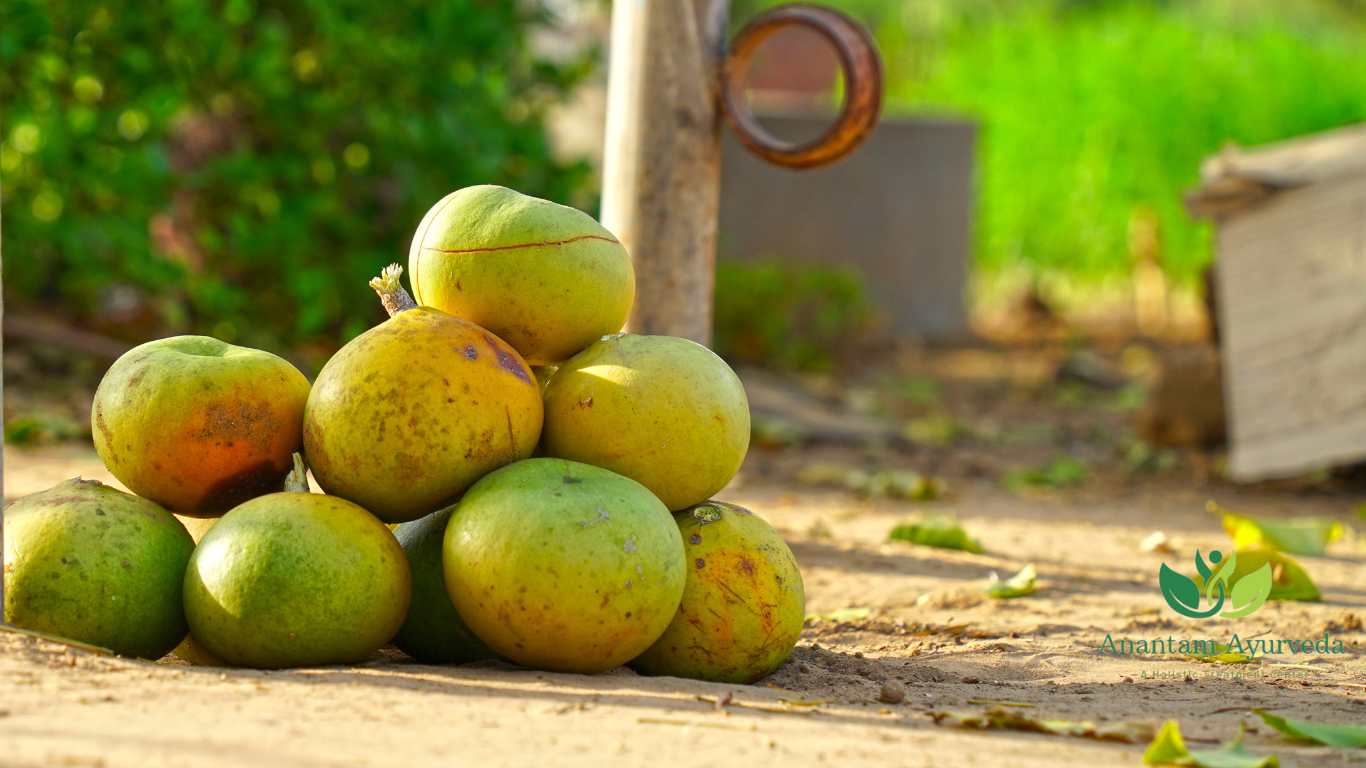
Research on Bilva (Aegle marmelos)
Aegle marmelos, also known as Bilva or Bel, is a plant widely known for its therapeutic properties. Modern scientific research has validated many of the plant’s traditional uses, particularly for its medicinal value in various health conditions. Below are some key research findings:
Phytochemical Constituents
Bilva contains several bioactive compounds that contribute to its pharmacological activities, including:
-
Alkaloids: Particularly aegeline
-
Flavonoids: Such as rutin and marmesin
-
Coumarins: Including xanthotoxol and imperatorin
These compounds play a crucial role in Bilva’s antioxidant, antimicrobial, and anticancer properties.
Medicinal Research Findings
-
Antidiarrheal Activity
Research shows that Bilva effectively reduces the frequency and severity of diarrhea, making it a natural remedy for gastrointestinal distress. Its properties help in managing conditions like dysentery and diarrhea. -
Antimicrobial and Antiviral Properties
Both fruit and leaf extracts of Bilva demonstrate significant antimicrobial and antiviral effects. The plant’s extracts can potentially treat a variety of infections caused by bacteria and viruses. -
Anticancer Potential
Bilva fruit pulp extracts have shown anti-cancer properties, particularly in inhibiting the proliferation of breast cancer cells in animal models. This suggests a promising potential in cancer prevention and treatment. -
Antioxidant Effects
Bilva exhibits powerful antioxidant properties. Research indicates that it helps neutralize harmful free radicals, protecting cells from oxidative stress. This protection can reduce the risk of diseases like cardiovascular conditions and aging. -
Radioprotective Properties
Studies on Bilva’s radioprotective effects suggest it can reduce DNA damage and lipid peroxidation caused by radiation exposure. This could be particularly valuable for cancer patients undergoing radiation therapy, providing natural protection from radiation damage. -
Antidiabetic Effects
Research highlights Bilva as a potential aid in managing diabetes mellitus. The plant helps regulate blood sugar levels, making it a useful adjunct therapy for diabetic patients. -
Hepatoprotective Effects
Bilva has demonstrated liver-protective properties, particularly in protecting the liver from damage caused by toxic substances like carbon tetrachloride. It shows promise in managing liver conditions and supporting overall liver health.
Safety and Precautions
While bilva offers a plethora of health advantages, it’s crucial to exercise caution. Pregnant or breastfeeding individuals, as well as those with underlying health conditions, should consult a healthcare professional before incorporating it into their routine. It’s advisable to start with small quantities and monitor for any adverse reactions.
How to Use Bilva Patra for Diabetes?
Bilva patra have garnered attention for their potential to manage diabetes. Consuming a concoction made from dried bael patra may help regulate blood sugar levels.
-
Take 10-20 ml of fresh Bilva leaf juice on an empty stomach.
-
Dry Bilva leaves, powder them, and take ½ teaspoon with water daily.
-
Prepare Bilva leaf decoction and consume it twice a day.
Can We Eat Bael Patra Daily?
Incorporating bael patra into your daily routine can indeed be beneficial, thanks to their nutritional value and health-enhancing properties. However, like any herbal remedy, moderation is key. Consulting an Ayurvedic practitioner or healthcare expert can help you determine the ideal dosage and frequency based on your individual constitution and health goals.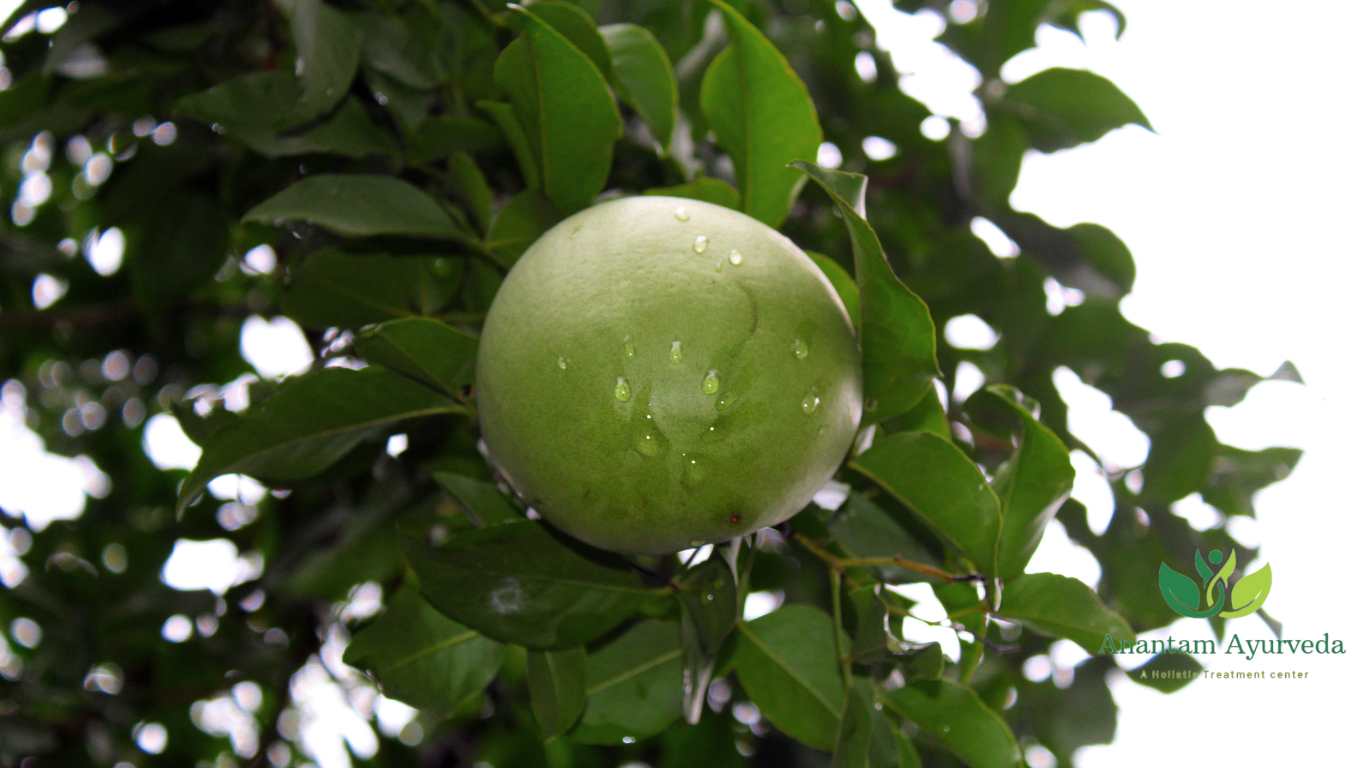
How to Eat Bel Patra?
Consuming bel patra may be an acquired taste for some, but their potential benefits make them worth exploring. One approach is to wash and chew a few fresh leaves, extracting their juices and nutrients. Alternatively, bel patra can be used in various culinary preparations, such as chutneys or teas, to make their consumption more palatable.
Concluding Thoughts
In the realm of natural remedies and traditional healing, Bilva holds a distinguished place. Its versatile applications and profound effects on health and well-being make it a treasure trove of wisdom from the ancient past. By incorporating it into our lives mindfully and with guidance, we can harness its potential to optimize our health and vitality.
In a world brimming with modern solutions, it reminds us of the enduring value of nature’s gifts. Let us journey together towards holistic wellness, drawing inspiration from the age-old wisdom encapsulated in the sacred tree.
Remember, nature’s remedies are best experienced when approached with knowledge, balance, and reverence. Embrace the power and embark on a journey of health, rejuvenation, and connection with the healing forces of the natural world.
Frequently Asked Questions
How to Eat Fresh Bel Fruit
1. How to Eat Ripe Bel Fruit:
-
Peel the skin of the Bel fruit.
-
Mash the pulp well and soak it for 2-3 hours before eating.
2. How to Make Bel Juice:
-
Scoop out the pulp by cutting the Bael fruit.
-
Mash the pulp thoroughly.
-
Strain the mixture to separate the juice and drink.
What Does Bel Taste Like?
Bel has a distinctive taste. Initially, it tastes like a combination of mango and banana. After a few moments, it turns slightly astringent and refreshing, making it a unique flavor experience.
Is Bel Wood Edible?
Bel wood is not edible and does not have any known medicinal properties.
Can Bel Upset the Stomach?
Unripe Bel fruit is highly effective for treating diarrhea, dysentery, and other gastrointestinal issues. However, consuming it in excess may cause constipation due to its absorbent (Grahi) nature.
Tip:
-
Take 1-2 teaspoons of unripe Bel pulp.
-
Dry roast it and add sugar and honey.
-
Consume it once or twice a day to alleviate diarrhea and dysentery.
Is Bel Juice Safe for Asthma?
Bel fruit and its juice are beneficial for respiratory issues like asthma, cold, and bronchitis due to its Kapha-balancing properties. It helps ease breathing and reduce congestion.
Is Bel Good for Diabetes?
Yes, Bael is an excellent choice for managing diabetes. It lowers blood sugar levels and stimulates insulin secretion. Additionally, its antioxidant properties help prevent complications related to diabetes.
Is Bel Good for the Liver?
Bael supports liver health with its antioxidant, anti-inflammatory, and hepatoprotective properties. It helps protect the liver from damage, including that caused by alcohol consumption.
Can Bel Help with Ulcers?
Bael has anti-ulcer properties. The compound Luvangetin found in Bael has strong antioxidant effects that reduce oxidative stress and prevent the formation of gastric ulcers.
Does Bel Act as a Contraceptive?
Bael has shown promise as a male contraceptive. Animal studies indicate that Bael bark reduces testosterone levels, inhibits sperm formation, and decreases sperm count and motility, thus preventing pregnancy. Fertility is restored after discontinuing treatment.
Can Bel Help Manage Asthma?
Yes, Bael has anti-asthmatic and antihistaminic properties. It reduces contractions in the trachea caused by allergens and lowers phlegm production, improving asthma symptoms.
Is Bel Fruit Safe for Pregnant Women?
Bael fruit can help reduce vomiting during pregnancy. A mixture of boiled rice water and unripe Bael pulp consumed twice a day may help control pregnancy-related nausea.
Can Bilva Control Cholesterol?
Yes, Bael is effective in controlling cholesterol levels. Its antihyperlipidemic properties help lower bad cholesterol (LDL), triglycerides, and total blood cholesterol while improving good cholesterol (HDL) levels.
Tip:
-
Take 1-2 teaspoons of roasted Bael pulp.
-
Mix with hot water and stir for 1-2 minutes.
-
Drink to regulate cholesterol.
What Are the Benefits of Bel Patra?
Bael leaves offer several health benefits. They have a mild laxative effect, promote digestion, and help manage conditions like cough and bronchitis due to their expectorant properties. Additionally, Bael leaves have anti-inflammatory benefits for fever and eye infections.
Does Bilva Cause Rashes?
Bael does not cause rashes due to its healing (Ropan) properties. However, people with sensitive skin should consult a doctor before applying Bael products.
Does Bilva Promote Wound Healing?
Yes, Bael promotes wound healing by encouraging the formation of new skin cells and helping wounds close faster.
Can Bilva Be Used for Eye Infections?
Bael leaves are effective in treating eye infections like conjunctivitis. A decoction of Bael flowers can be used as an eye lotion to alleviate symptoms.
Can Bilva Be Used for Burns?
Bael fruit powder is excellent for treating burns when applied externally.
Tip:
-
Mix Bael fruit powder with mustard oil.
-
Apply to the burn area.
Can Bilva Be Used for Ear Infections?
Yes, Bael can help manage ear infections due to its astringent and anti-inflammatory properties, reducing inflammation and pus discharge.
Can Bilva Be Used for Leprosy?
Though limited evidence exists, Bael may aid in managing leprosy symptoms due to its healing properties.
Tip:
-
Dry and powder Bael leaves.
-
Sprinkle on affected areas after a bath.
Does Bilva Help with Leucoderma?
Yes, Bael plays a role in managing leucoderma. The compound Psoralen in Bael helps increase skin tolerance to sunlight and aids in restoring the natural color of the skin.
Can Bilva Juice Treat Skin Rashes?
While scientific studies are limited, a mixture of Bael fruit, Strychnos nux vomica seeds, and Pongania pinnata, boiled with coconut oil, has been shown to help treat skin rashes.
Tip:
-
Mix 1-2 teaspoons of Bael juice with coconut oil or rose water.
-
Apply to the affected area, leave for 4-5 hours, and wash with tap water.
What Are the Benefits of Bel Patra for Hair?
Bael leaf oil, rich in limonene, is used in hair tonics and helps combat dandruff, itchy scalp, and excess oil. It balances Kapha dosha, improving hair health and adding natural shine.
Tip:
-
Mix Bael powder with coconut oil and massage into your scalp.
-
Leave for 4-5 hours, then rinse with shampoo and water.
You can also read about Gambhari (Gmelina arborea): Gambhari Oil for Breast
You can follow us on twitter, facebook, instagram & Google News

🤓